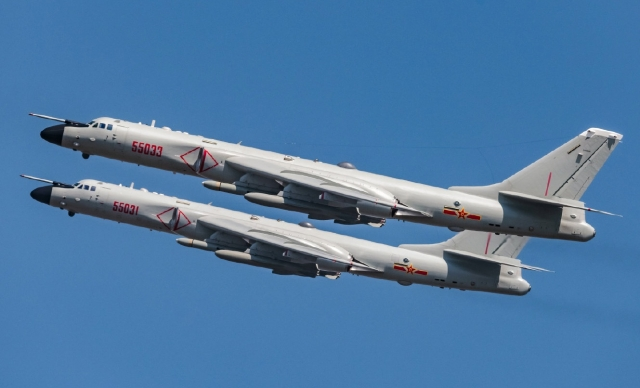The maneuvers of the US Navy in the China Sea no longer seem to impress Beijing, which now has a new generation of long-range strategic bombers, some of which would be equipped with hypersonic nuclear missiles.
APL shows the teeth
In early February, the American aircraft carriers Nimitz (CVN-68) and Theodore Roosevelt (CVN-71) conducted exercises in the South China Sea. It was a demonstration of power for Washington, which wanted to restore the freedom of navigation disputed by Beijing. The response of the APL Southern Theatre Command was not long in coming. Indeed, it has since conducted major air exercises with the use of H-6K, H-6N and H-6J bombers. These actions, which have been able to bring together up to 10 aircraft simultaneously, have highlighted the ability of these new bombers to act and fight back. This training focused in particular on anti-ship warfare with the intensive use of the new H-6J, specially designed for the Chinese navy. It should be remembered that the bombers never fly alone; they are escorted by an equivalent number of Su-30 MKKs. Moreover, they benefit from the presence of Il-78 tanker aircraft, AEW, Y-8G electronic warfare. But this posture is not only defensive, Beijing also seeks to demonstrate its projection capabilities in the same way as the US Navy.
H-6K, H-6J: Towards the second chain of islands
After Moscow's refusal to supply Tu-22M3s, Beijing developed the H-6K, which has been operational since 2011. Twenty examples were delivered to the 8th Air Division, facing Taiwan. Equipped with new Russian D-30KP2 engines, the range was extended to 3,500 kilometers. The H-6K has six payload points for 12 tons of ammunition. Each bomber is capable of firing 6 KD-20 and 4 KD-63 short-range missiles for ground attack or anti-ship missions. The fleet is estimated at around 40 in 2019. The Chinese navy would also have about twenty units adapted to its missions: the H-6J. It would embark up to 6 YJ-12, and could carry two jamming pods under its wings to neutralize the anti-aircraft capabilities of enemy ships. For several months now, these aircraft have landed on certain artificial islands in the China Sea to symbolize Beijing's sovereignty over it.
H-6N: Towards the third chain of islands and the nuclear triad
First displayed at the October 1, 2019 parade, the H-6N made a notable appearance as it features two major modifications over the H-6K. First of all, it is systematically equipped with an in-flight refueling arm, whereas the H-6K was only sporadically equipped with one. This allows the H-6Ns to be replenished by the 3 Il-78 MPs purchased from the Russians, which almost doubles their range to between 6,500 and 7,000 km, according to the assessments of the PLA magazine Kanwa, published in Canada. Above all, although the H-6N has only four payload points, its internal hold has been removed and its cell refitted to accommodate a new weapon. In 2013, the Pentagon had already reported in its annual report on the Chinese threat, suspicions about a nuclear version of the CJ-10A cruise missile, intended for the H-6K bomber, which would bring it to 2000 km. But above all, the DIA revealed in March 2018 before Congress that an aerial version of the DF-21 medium-range two-stage ballistic missile would be tested since the end of 2016. A missile that the Pentagon has named "CH-AS-X-13," which would extend to 3,000 km and could be equipped with a hypersonic glider maneuvering to keep anti-missile systems in check. According to the most pessimistic evaluations, the H-6N would thus be capable of hitting targets more than 9500 km from the Chinese continental shelf.
Découvrez cet article sur Air&Cosmos

